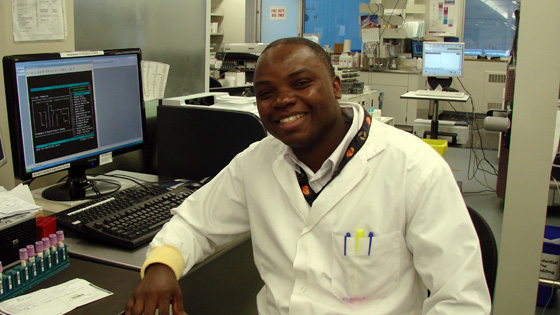
Above, UHN laboratory technologist Kwabena Boateng says sharing lab resources
provides more efficient care for patients.
As a laboratory technologist, Kwabena Boateng, 31 of Brampton, Ont., knows the benefits of collaboration and working together.
"As a child growing up in Ghana, West Africa, I was taught the value of sharing and getting along well with others," said Boateng, who works in University Health Network's Laboratory Medicine Program, a joint program with Sunnybrook Health Sciences Centre (SHSC) in Toronto.
"Now, I see the benefits of this every day when we work closely with our partner labs in order to get the important results to our patients as quickly as possible," he continued.
Laboratory medicine at Sunnybrook and UHN have been working together and sharing resources, including medical and administrative oversight, for some time.
Shared system 'makes sense'
Recently, the labs have been investigating a single Laboratory Information System (LIS) that could support both core laboratories. An LIS is an electronic management system that manages the patient test orders and results and other data related to the laboratory.
Advantages of a single LIS includes test rationalization, seamless test ordering at either site and overall shared system functionality that reduces duplication of costs.
"This type of collaboration will allow for better use of resources and support more comprehensive data mining for clinical and research processes," says Suzanne Waldman, LIS manager, Sunnybrook.
According to Peter Woo, LIS manager at UHN, "a shared system makes sense. As SHSC already has functionality that UHN needs, it can be deployed at UHN without purchasing it separately."
Maximizing resources
"Leveraging these opportunities for integration, you create new value when you work and learn from each other, plus we save time and money by not always having to rebuild everything," said Brad Davis, Executive Director, Laboratory Medicine, UHN and Sunnybrook.
"Plus a single system will provide value to patients and clinicians as it is easier to share orders, results and data without difficult work-arounds," Davis added.
Sam Marafioti, Vice President of Corporate Strategy & Development and Chief Information Officer of Sunnybrook Health Sciences Centre, said, "our laboratories lead the pack in exploring ways to ensure we have a sustainable, affordable and strategic plan for moving forward in our complex healthcare system."
Marafioti noted this type of integration ensures the best service for patients. It's also a more efficient way to work with partners in the healthcare system, he noted.
Patient safety improved
Tom Clancy, Director, Laboratory Operations at UHN, explained that an integrated LIS will reduce waste and increase efficiencies. This is because "the process of moving specimens and reporting back results at any of our hospital labs will be streamlined," he said.
Lisa Merkley, Director, Laboratory Medicine at Sunnybrook also noted that patient safety would also be improved since the electronic ordering and reporting between institutions would be made more efficient.
She also said there would be "a reduction in turnaround time of the clinical decision making process translating into improved patient care."
Making a difference
For Boateng, it means he can feel even more confident in the service he and his team provide.
"I work in the lab because I enjoy being a part of the care team that makes sure the clinicians, the patients and their families have the information they need," he said.
"Being able to share this information across our partner hospitals is just another way of ensuring everyone has the data and results they need to make a difference in someone's life," he added.
